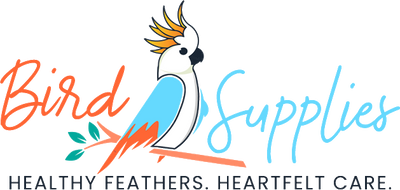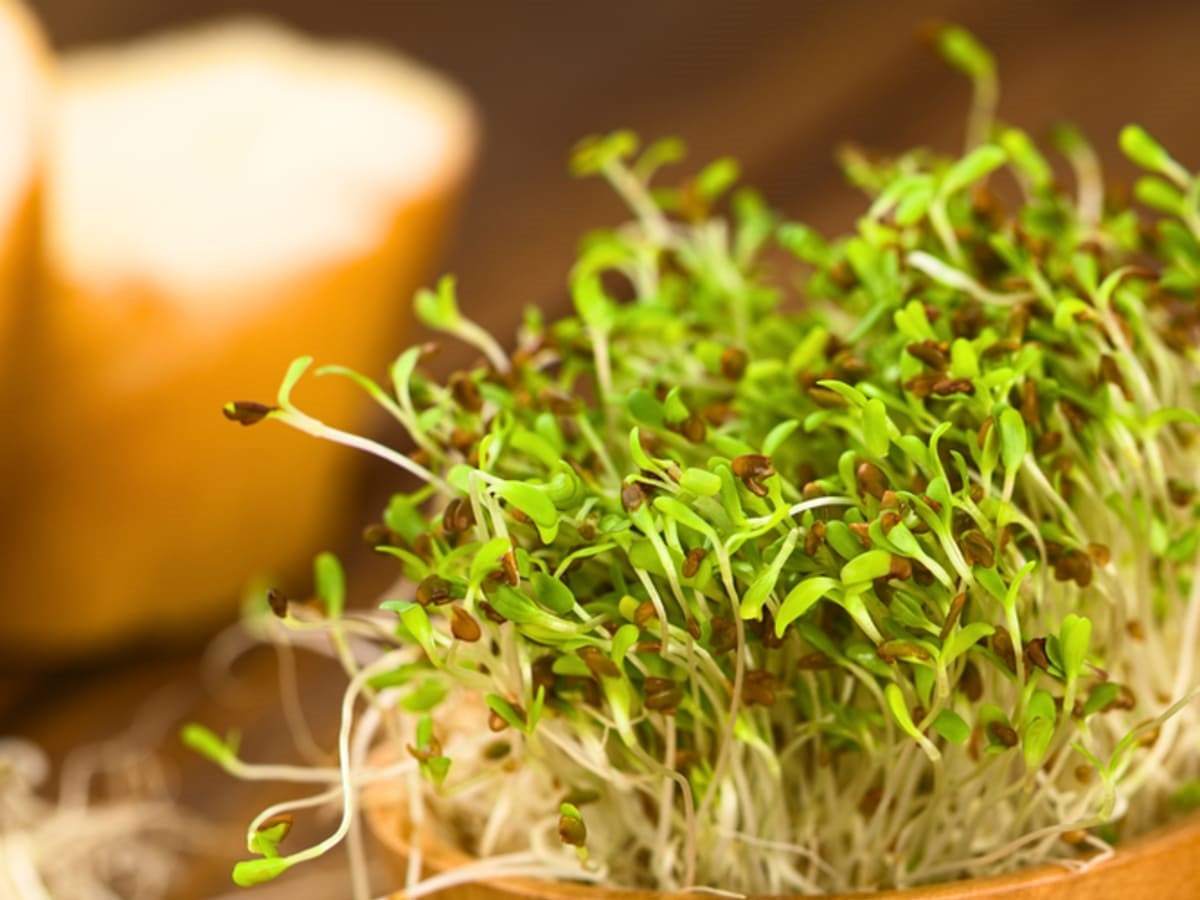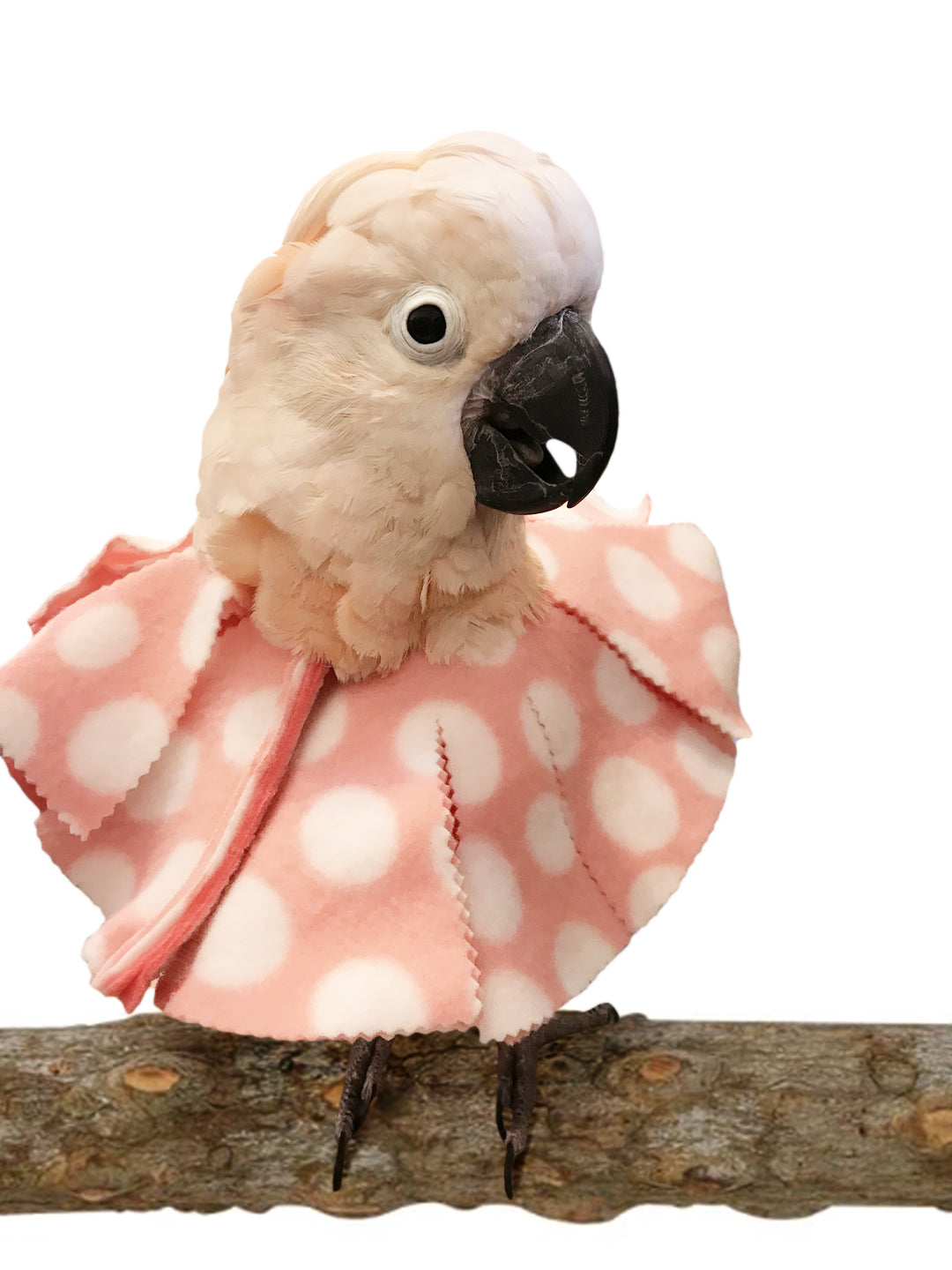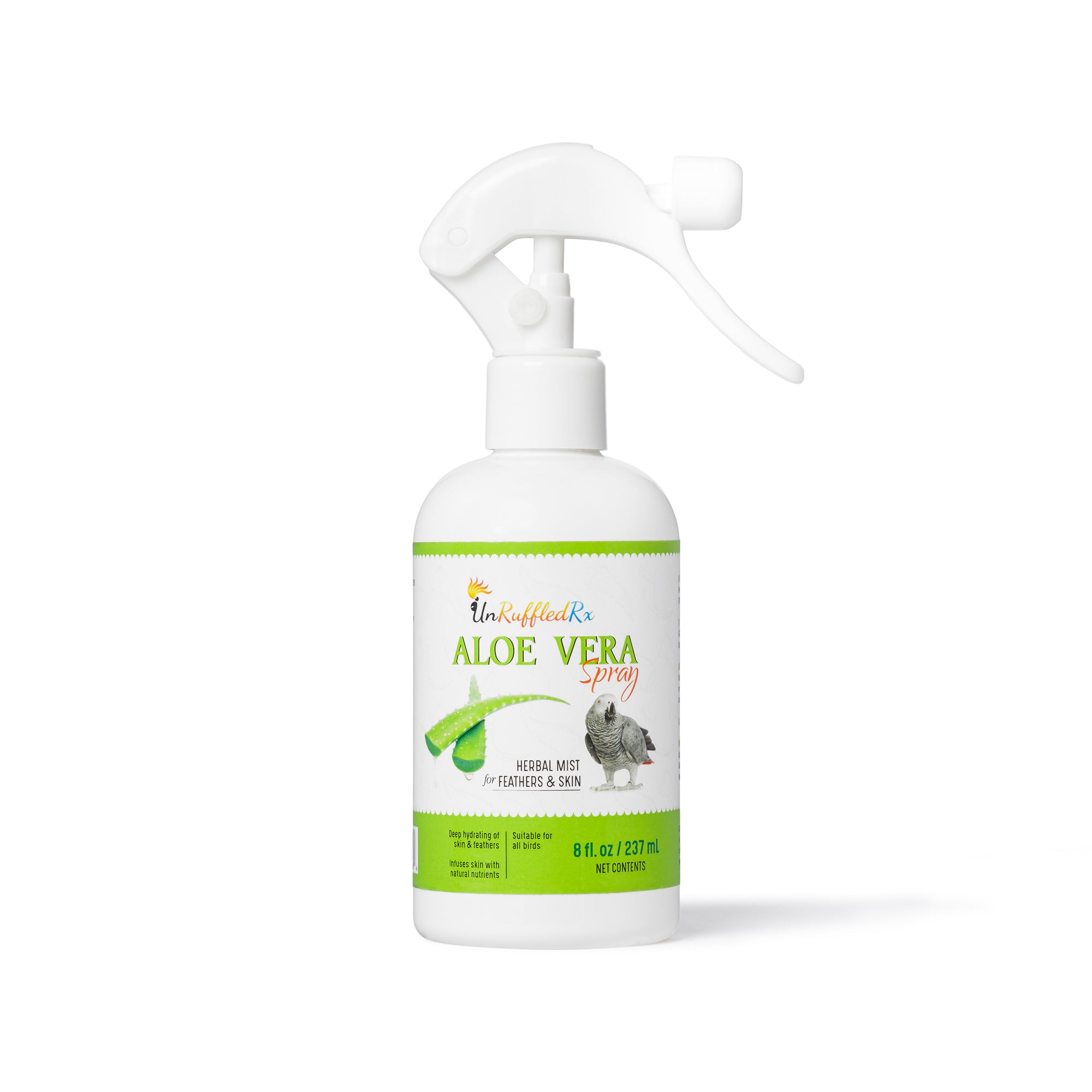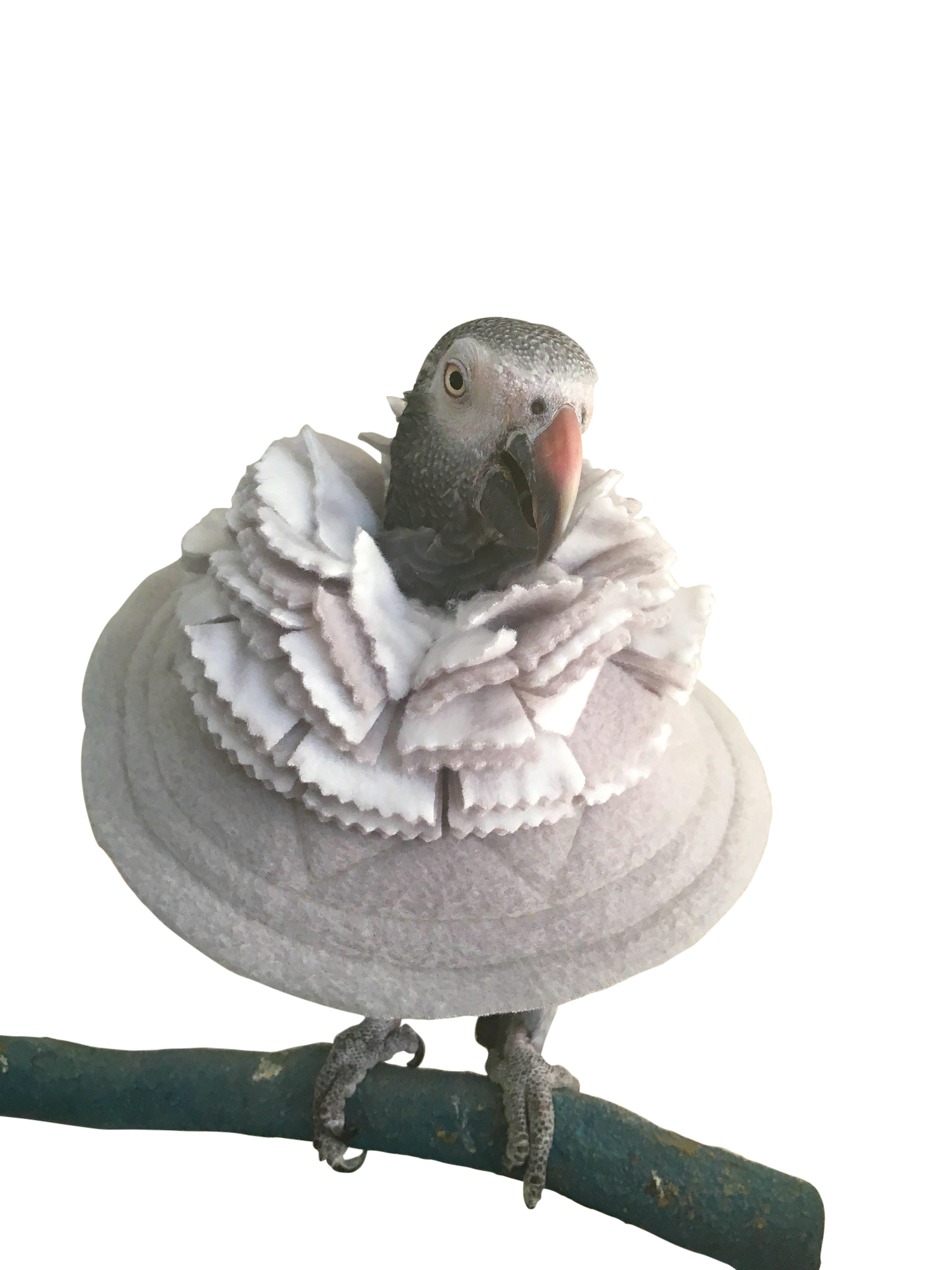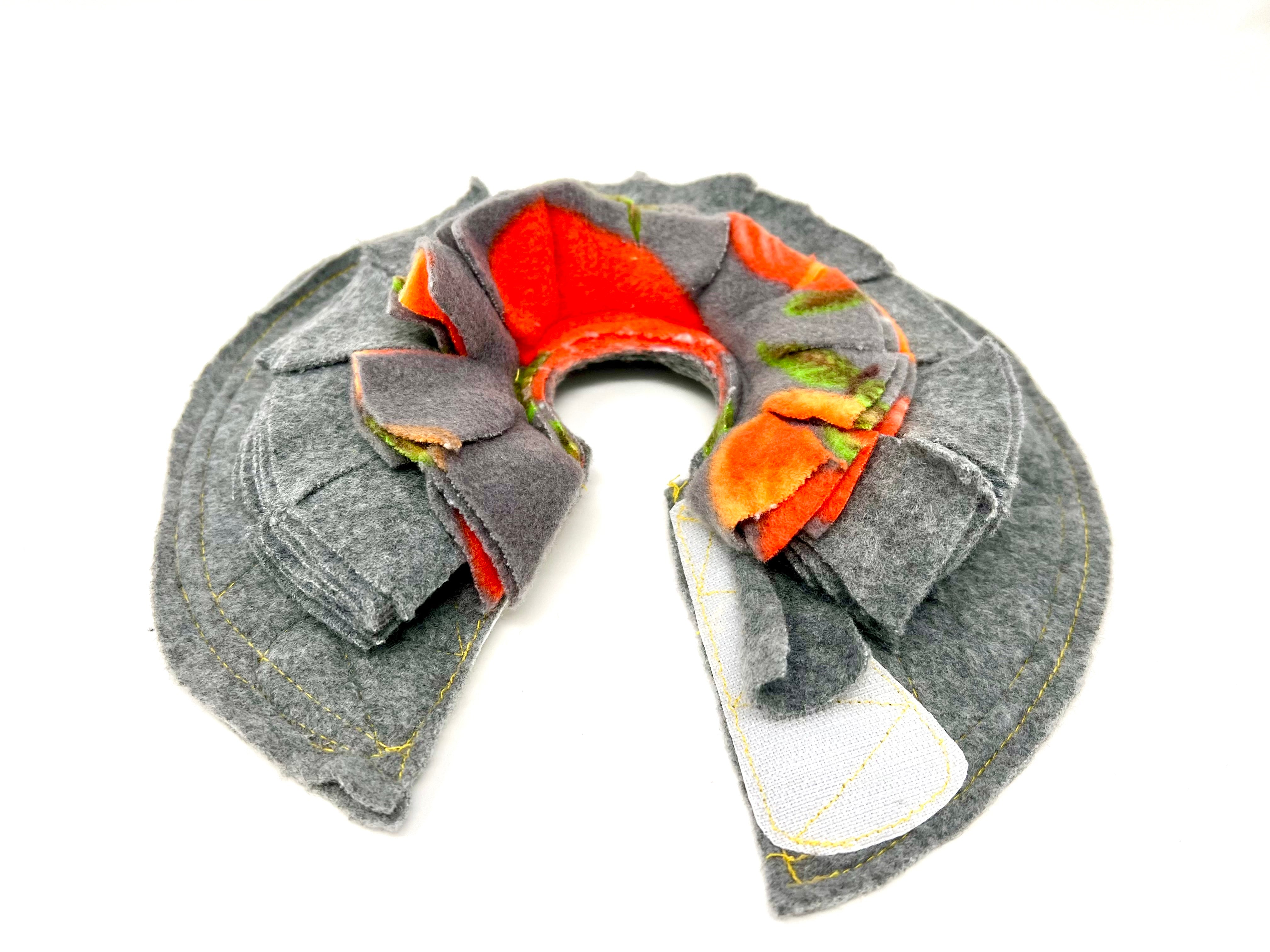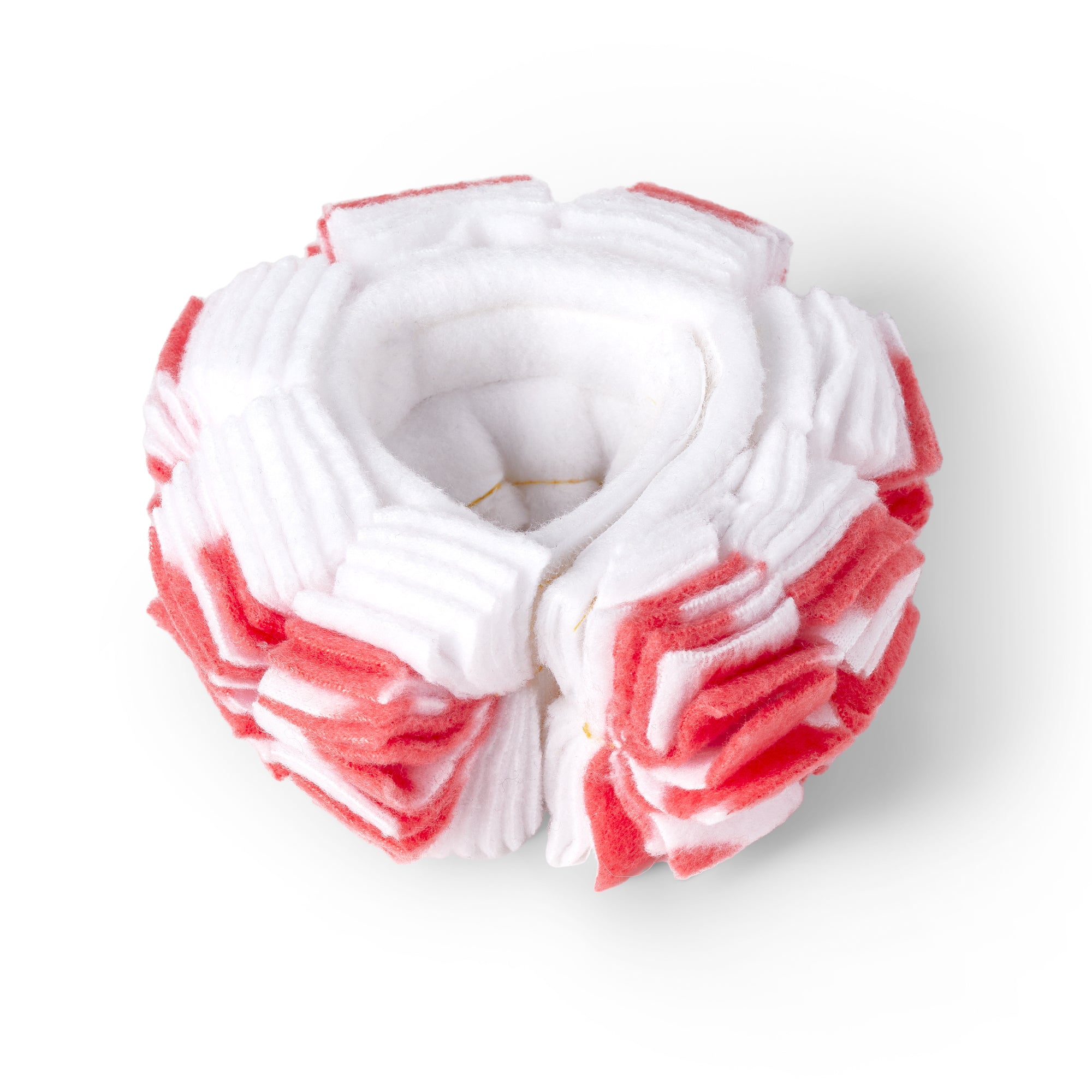Table of Contents
Imagine your bird suddenly turns aggressive and you can't figure out why. Or maybe you wake up one morning to a pile of feathers on the bottom of the cage. Birds can develop challenging behaviors quickly. They can become anxious or aggressive for a number of reasons. In this blog post I'll explore one of the most effecting strategies for dealing with challenging bird behavior, environmental wellness.
Common Challenging Bird Behaviors
- Lethargy
- Screaming
- Biting
- Aggression
- Feather Plucking
I have a lot of clients contact me for help with challenging bird behavior. They tell me that they've tried everything they can think of but nothing has worked to solve the problem. People describe how they’ve changed their bird’s diet or they've worked on improving its sleep cycles. Or they've purchased an array of bird toys just to watch them gather dust. It is so frustrating!
Some people even re-home their bird because they're not sure how to improve bird behavior. They feel like they are failing their pet.
Before you take extraordinary measures, like rehoming your bird, how about learning some of the most effective behavior change strategies that we, as bird behaviorists know. It's not rocket science, it's behavior science!
What Causes Challenging Bird Behavior?
Let me back up a bit here. Pet birds are considered exotic pets. That is that they’ve not been domesticated yet. Birds, in general, are such a unique animals and they have different care needs than more common pets like dogs or cats. Everything about them is geared towards flight. Birds require special diet that provides plenty of energy yet doesn't result in a lot of weight gain. Being lower on the food chain, birds rely on flock mates for they are mere survival.
Flock members search out food sources and call out about their fine to the rest of the flock. They also check on each other every morning and evening to make sure that everyone's okay. And, they warn each other of potential danger and often work together to chase off the intruder. Ss you know, birds are very social.
Our pet birds are very intelligent, very social, and they have an incredible amount of energy. They can also be quite anxious and they are prone to feeling bored and lonely. Plus, they have some specialized care needs that, if not properly met, can cause a lot of problems both physically and emotionally. And that's where bird behavior problems arise.
Hey, don't come down hard on yourself! Doctors of veterinary medicine have to undergo at least 2 years or more I've supervised training past veterinary school in order to become a certified avian veterinarian. Animal behaviorist can take hours of post graduate continuing education to work toward avian certification. There's a lot to know!
In this blog post, I'm going to give you some Insider secrets on some of the most important aspects of bird care that can support positive in our feathered friends.
How Do You Stop Aggressive Behavior in Birds?
I'm talking about applied behavior analysis (ABA). We've been doing research on how to change challenging behaviors for over a century now. There are reams and reams of research that show us how to change challenging behavior. We know the most effective strategies for various types of behavior, too. For instance you’d use different strategies for changing aggressive behavior than you would for resolving fears, phobias, and anxieties.
But, the most effective strategy for positive behavior change in our pets is ensuring for the pets wellness and welfare. As a matter of fact, adjusting your bird care routines to enhance your pets wellness and state of mind is literally the most effective thing you can do to improve challenging behavior. Implementing just some of the strategies generally doesn't work. Our birds are physically, emotionally, and socially complex oh, so we found that developing a systematic approach toward wellness is essential.
Okay?! I'll bet you're wondering where do I start. The Richard M. Schubolt Parrot Wellness and Welfare Program at UC Davis School of Veterinary Medicine is dedicated to the education and clinical care of companion parrots, providing optimal quality of life, disease prevention and treatment. They have a lot to say about what caring for our companion birds should look like.

As of this writing, they have identified six major factors for enhancing the wellness and Welfare of your pet bird.
- Preventative Health
- Nutrition
- Behavior Training
- Environmental Enrichment
- Pain Prevention and Management
- Pediatric and Geriatric Care
Let's tackle each of these recommendations individually. But, in the end, it is critical that you create a system where by you, as your bird caretaker, are ensuring that each recommendation is thoroughly addressed.
 |
But, in the end, it is critical that you create a system where by you are ensuring that all parrot wellness recommendations are thoroughly addressed. |
1. PREVENTATIVE HEALTH CARE
Preventative health 8is important for all animals. But it's particularly important for our pet birds. You may know that parrots hide Illness and injuries. One sick flock member can endanger several other flock members. So, if a bird is acting puny or unwell in the flock, its flock mates will likely drive it away. After all it would just take one predator to come in and raise havoc endangering the entire flock.
Your pet bird will hide any illness from you, as well. Here at BirdSupplies.com we hear sad cases of this all of the time. The earlier that an illness is caught the better the outcome tends to be. Annual check-ups are a must. And, so is preventative health care.
Our birds have complicated health and wellness routines needs. They require a highly specialized diet to avoid malnutrition. They also need adequate exercise to stay limber, in shape, and pain-free. They have complex social needs, that if unmet, can result in painful depression and anxiety. A full range of sensory inputs and intellectual stimulation helps to ward off depression and anxiety. Our pets can become chronically hormonal causing unsafe aggression and a host of medical problems. And, did I mention that parrots need between 10 and 12 hours of sleep per night. That alone makes it hard to socialize with your pet after you get home from work in the evening.
As you can see, without a system in place, caring for your pet bird can turn into a full-time job. It's easy to see why avian veterinarian medicine and behavioral health certifications take awhile to get.
Preventative Care That Supports Wellness
|
I'd encourage you to use the attached worksheet to map out morning and evening routines, as well as daily, weekly, and monthly routines. It will also help if you divvy up bird care routines among family members.
The other items on the Richard M. Schubolt Parrot Wellness and Welfare Program list will be described in greater detail below.
2. NUTRITION
Avian veterinarians tell us that complications from poor nutrition make up the majority of their practice. Essentially, without proper nutrition, your birds organs won’t perform well and essential body systems can eventually stop working. It's a slow and ugly process. Plus, your bird ends up feeling horrible. No one wants that for their beautiful parrot.
It might feel like you have to be an avian nutritionist to uncover how to properly feed your pet bird. You're not going to get that information off of the back label of a bag of bird food that you find it PetSmart. Even a specialty bird store may not offer adequate bird dietary information. Think about it. They make their money off of selling you premium bird pellets. Pellets are part of a healthy diet for a bird, but birds need more than just pellets to thrive.
The reality is that your bird needs as much as 60% of its diet to be made up of fresh uncooked plant-based foods. The other 40%, give or take, depending on the bird species, should be a premium bird pellet. I'll describe basic but important avian nutrition information here, however, if you want to know which plant-based foods compliment each other to increase the bioavailability of nutrients, I’d suggest that you buy a bird-specific, raw food based cookbook. Always follow recipes to maximize the bioavailability of important nutrients.
Let’s face it. You’re not going to find pellets, safflower seeds, or millet in the jungles of Africa or the rainforests of South America. But, what you will find is a diverse range of plant-based vegetation, fruits, flowers, seedlings, and protein-packed seed pods that wild birds spend more of the day foraging for.
Essentially, you'll want to feed your parrot using this formula:
1. 40% of your birds diet should be made up of a premium, science-based bird pellet. Three brands stand out from the competition. I've seen these same three brands mentioned by well-known avian veterinarians across the globe.
- Harrison's Bird Foods
- Roudybush Pellets
- TOPS Bird pellets
2. 60% give or take of the diet should be a vast and diverse range of raw (uncooked, fresh, plant-based food items). We're talking a variety of bird safe vegetables, low-sugar fruits, herbs, flowers, nutrient-dense seeds, grains, and, nuts. If your bird refuses to eat vegetables I've got a great video that can help you out here.

Photo: Diane Burroughs, 2021
If your bird is used to eating only a seed or pellet diet take a few weeks to transition it to the new diet so that you don't upset its stomach.
It takes a little time to prepare a raw food diet, so you may as well make a batch and freeze most of it. Imagine if you were to make a months worth of 3 super nutritious recipes in one afternoon and freeze it. blanching fresh vegetation allows it to freeze well. This can be done on the stovetop or in the microwave.
Here's some utensils that you may need to blanch raw foods:
- A food processor to chop vegetables into fine, rice-sized pieces
- A large pot to blanch fresh fruits and vegetables in preparation for freezing OR
- A glass baking dish to microwave-blanch fresh, raw foods
- A straining colander
- Zip style bags to freeze servings
3. ENVIRONMENTAL ENRICHMENT
We hear so much about environmental enrichment that it almost seems like a buzzword. But in truth, it is really important for your birds overall wellness. But what exactly does it mean?
Think of environmental enrichment as stimulating your birds senses and intellect as much as possible. We know that our birds have high energy levels and that they're very intelligent. Allowing a cage to pet to get bored is a recipe for disaster. Some birds get so bored that they'll resort to aggression or self-harm behaviors to deal with the stress.
Experts teach us that there are five different types of enrichment that we can offer our pet birds. You will of course want to rotate the enriching strategies that you offer so that your bird feels like it has a novel experience each day.
Sensory Enrichment: Did you know that your bird has better hearing than a dog and that its vision is way superior than ours is. It gets quiet in the rainforest and jungles when a predator is nearby so a lot of birds react negatively to a quiet environment.
Birds don't have very many taste buds so their sense of taste is poor. However, the tip of its tongue has so many nerve endings that it can detect a tiny seam in a hard-shelled nut and crack it in an instant. There's not much research about a bird's ability to smell. And, in terms of kinesthetic sensory input, you’ve probably figured out that birds are extremely dexterous. They’ve got of muscles in each foot and their zygodactyl or yoke-toed feet are adapted for climbing, grasping, and manipulating objects.
Our birds feel safer when there’s background noise in their environment. Auditory sensory enrichment is especially important for birds that are experiencing separation anxiety. Remember that flock like noises, chirps and squawks or any chattering bird for that matter can make your bird feel more comfortable. You can supply the necessary noise that your bird needs by leaving a television or radio on while you're away. My birds love Parrot TV on YouTube.

Photo: Diane Burroughs, 2021
If your bird has separation anxiety make recordings of your voice to play for it while you're gone. I had a customer once who said that her bird started plucking when her son left for college. I encouraged her make auditory and video recording of her son to play for the bird. It was very helpful.
Visual stimulation is important, too. Imagine being a flock animals that is left alone all day, locked in a cage and looking at four walls. That's got to be really tough for an intelligent, busy bird. Irene Pepperberg, Ph.D the famous parrot intelligence researcher, has demonstrated just how intelligent birds are. Her studies have informed us that birds can count, identify colors, identify various objects, solve problems, and even used tools.
Offer your bird new and novel things to look at and manipulate. Colorful toys can offer an element of visual stimulation. Frequently rotate toys so that your bird doesn't get bored of them. And, most birds love watching th television. My own love Parrot TV program on YouTube.
Kinesthetic enrichment involves providing your pet with opportunity to move its body and get much-needed exercise throughout the day. I have a dedicated bird room with a ceramic tile floor and have a foraging tree right next to the open cage door. The room is easy to keep clean because of the ceramic floor. My birds can climb all over the cage and all over the tree, and I encourage exercise by offering foraging stations on various branches of the tree.
Another way to provide enrichment is through socialization. Your bird considers you, your family, and your household pets to be part of its flock. I've already mentioned that in the wild birds are never alone and how birds feel safer when surrounded by flock members. Get your bird out of its cage so that it can socialize with you and your family as much as possible.
Piggybacking off of the Pepperberg studies, birds like having a job to do. Providing occupational enrichment will give them something to do. In the wild, birds spend their time foraging for food, grooming themselves, creating a nest in hollowed-out trees, figuring out how to make use of items in their environment, and more. Discover how to make foraging toys for your bird to keep it busy throughout the day.
Foraging is anything that requires a bird to search and work for food. You can encourage foraging by providing your bird with foraging toys. There are several sites that can give you great, affordable ideas for foraging toys Just make sure that the foraging items that you offer are bird safe. You can find out more about how to teach your bird to forage in my foraging book or on my YouTube channel.
These are just some examples of how you can provide your parrot with enriching opportunities. In summary, I've talked about sensory enrichment, physical enrichment, social enrichment, occupational enrichment, and enrichment true foraging opportunities.
If you've got some other ideas that work for you, please let us know about them in the comment section below.
4. BEHAVIORAL TRAINING
Being intelligent animals with complex social needs its important fo you to train your bird. I'm going to talk about two types of behavioral training that are important to know. You’ll need to teach your bird foundational behaviors as well as develop positive behavior strategies so that when challenging behaviors develop, you’ll be able to nip them in the bud quickly.
FOUNDATIONAL BEHAVIORS
In the wild, Mom and Dad teach their young everything they need to know for survival and how to engage with the flock. Once they've left the nest other flock-mates support ongoing learning. This learning includes things like what's safe to eat, how to forage for food, how to groom themselves, how to interact with flock members, and more.
Unless your bird was parent raised, it has not learned how to “be a parrot.” If it was hand-fed, it's actually imprinted on humans and doesn't know the least thing about how to be a parrot. In this case, you'll have to become a parrot parent.
Laying down foundational behaviors is one of the most loving things that you can do for your pet. This is true whether you've adopted a baby bird or rehomed an adult bird. First, your bird will know how to interact with all flock members in a safe manner. Second, when your bird reaches adolescence or becomes hormonal it will be much easier to redirect aggressive behavior. And, third, should you ever have to rehome your bird it will be a much more pleasant pet to be around if it has a learned important foundational behaviors.

Important foundational behaviors that you'll want to teach your bird include the following:
- Eating a healthy diet pellets and raw foods
- The importance of safely socializing with the entire “flock”
- How to bathe
- Where its preening gland is and how to use it, if it has one
- How to forage and play
- Coming out of its cage and going back in
- Staying in place, also called “stationing”
- Coming when called, also called “recall”
- Being handled, such as allowing you to manipulate its wings and feet for grooming purposes and allowing the veterinarian to handle it for an examination
The cool thing here is that all of this training provides your bird with added enrichment and socialization. The time you spend will make for a better pet in the long run. On top of that, your bird is less likely to develop challenging behaviors that are upsetting for both you and the bird.
If you're not sure where to begin, I'd encourage you to explore Clicker Training. All you need is a clicker, a small device that makes a unique clicking sound and your bird's favorite treats. First, you'll “load the clicker,” which is just a fancy way of saying that you're teaching your bird that every time you click it gets it a treat. It won't take long at all.
Once your bird has associated that hearing the clicking sound means that is going to get a treat, you can start behavior training. Simply put, you try to elicit the behavior that you want to see, then, click and treat. For instance, if I'm trying to teach my bird to step up on my finger so I can take it out of the cage, I'd first want to reward it for picking its foot up. Then, I'd start rewarding it for putting its foot on my finger. Next start rewarding it for stepping completely up on my finger.
I'm sure you get the point. You break the behavior down into small, reachable steps that you can quickly teach. You reward the behaviors that you want to see and totally ignore the behaviors that are not related to what you're trying to teach. The positive reinforcement is so powerful that your bird will love the training sessions.
Most birds learn very quickly. In fact, spending just 15 minutes a day on clicker training will had huge benefits now and in the long run. If you need more support with clicker training, grab a copy Melinda Johnson’s popular book, Clicker Training for Birds.
If your bird has developed a challenging behavior like feather plucking, screaming, or biting, you'll want to learn positive behavior change strategies. Essentially, positive reinforcement is rewarding desired behaviors - behaviors that you want to see more of. Basically, you're reinforcing or promoting a replacement behavior.
Your bird will quickly learn to associate performing the “target behavior” with a reward. You'll elicit the behavior with a cue, like saying “Step Up.” Then, when your bird steps onto your finger you quickly reward it.
You can teach any number of new behaviors in this way. Then, just cue the new bird behavior when you want it to stop doing an undesired behavior.
5. PAIN PREVENTION & MANAGEMENT
Pain prevention and management is another way to offer your parrot environmental wellness. Pain is described by people as “one of the most negative experiences possible” (Mellor & Bayvel, 2011). Pain has both physical and emotional effects. It’s no different for our animals.
We are also aware that pain is a debilitating factor in healing from injuries. In other words, managing a birds pain in pet birds has been shown to speed up recovery. (Paul-Murphy,
Just like any animal, our birds can experience both traumatic pain and chronic pain throughout the course of their lives. Both are miserable. That’s why optimizing your birds environment for safety is an important preventative measure.
While it’s a little grim to think about, knowing the top 10 killers for pet birds can help you plan your prevention strategy.
A number of issues can cause intermittent pain, from accidents to health issues. According to Malik (2017), “Husbandry-related issues are frequent. Egg-binding, GI or respiratory conditions caused by inappropriate diet or environment and feather-destructive behavior are all conditions that have potential to cause some discomfort or pain.”
There are two essential things to know regarding bird pain. As I’ve discussed earlier, birds tend to hide illnesses and injuries so detecting when your bird is in pain can be difficult. It requires a skillful eye. Since birds hide pain and illness to ward off predators, it is vitally important to know your birds normal demeanor and activity level. Then, each morning when you do your morning care, assess your pet to see if it is acting normal. I'll share a checklist of how to tell how serious your bird’s pain is below. Keep a copy of this handy. I had to use a similar checklist for my old dog, Kelsey, and it was very helpful.
The other thing to keep in mind regarding bird pain is that many pain medications have not been well studied on birds. This may cause some veterinarians to be hesitant to prescribe medications for pain management. On top of that, birds tend to be fragile when it comes too aggressive forms of treatment, such as cancer treatment. This is another reason to develop a relationship with an avian veterinarian.
If you haven’t done so already, create an avian first aid kit. It goes without saying that normal nursing care as for any bird that is in pain is very important. Create a bird hospital cage so that you can offer a sick or injured bird a clean, warm, dry, quiet place to get some rest. Lower the perches, line the bottom with a towel to cushion a potential fall, and make food and water easily accessible. (Machin, 2014)
How To Know If Your Bird is in Pain

When a bird is in pain, some of its "normal behaviors" changed or subside. These include:
- Decreased social interactions: Perching away from other birds, decreased grooming of self or other conspecifics (birds of its own species), decreased interactions with owner.
- Guarding behavior. Change in posture to protect a painful area or hide it from you, decreased activity
- Increased aggression toward flock mates or owner
- Grooming behavior at painful site or generalized, feather-destructive behaviors, self-mutilation.
Pain Assessment in Birds
Download the Pain Assessment For Birds Questionnaire Now!
6. SPECIAL CARE FOR PEDIATRIC & GERIATRIC BIRDS
PEDIATRIC BIRDS
Bringing a new baby pet home is such a joy, but you have to keep in mind that it is still a baby and you want coming to your home to be as stress-free as possible.
You'll need to some important supplies for your new baby. Hopefully you've done your homework and know which supplies that you'll need. But, I'll name a few item set will come in handy:
- A comfortable appropriate sized bird carrier that will allow you to place the perch low near the bar.
- An appropriate sized birdcage. keep in mind the internal size of the cage and the bar spacing.
- Find out which diet your bird has been weaned on and buy some ahead of time.
- High protein seed like Millet and Bird Training treats.
- A few appropriate-sized bird perches
- A few appropriate-size bird toys
- Gram scale so that you can monitor your birds weight
The first several days will be stressful for your new pet. think of all the things your new pet will have to adapt to, new people, new routines, more handling then it's used to, and more. Make sure to keep things low-key and allow your new baby to get plenty of rest.
Hopefully you’ve found an avian veterinarian that you'd like to work with. Take your new baby and for an exam as soon as possible. Your avian veterinarian will be able to advise you on species-specific care taking skills that you'll need to acquire. The vet will also discuss preventive medicine with you to help you keep your baby healthy.
Anytime that you bring a new bird into the flock it is very important to realize that the bird is highly susceptible to becoming ill. Monitor the new baby's weight approximately every other day. This will allow you to know whether your pet is getting enough nutrition and to intervene if it is not eating enough.
Not only that if you have other bird’s, disease transmission is a potential problem. Plan to quarantine your new baby for at least 30 days.
During the first few months is a great time to start teaching your new baby foundational behaviors that were addressed earlier. Your new baby will look to you to teach it what is safe and what is not safe. Depending on its personality it may be anxious or it may be brazen but you'll have to be very careful to ensure that it stays safe from the start.
GERIATRIC BIRDS
We call older birds geriatric or seen your birds. Depending on the species your bird may live anywhere from 4 years 2 upwards of sixty years and like any animal or person that ages there are certain things that you'll need to pay attention to.
But, first let's talk about how to make accommodations for your pet birds in case of your untimely death. If you don't have family members who would be interested in caring for the animal you may want to explore various avian rescue organizations that offer estate planning for your pet. Another option is is to talk with your avian vet about resources for rehoming your birds. A lot of times people inquire about pet availability from avian experts.
Whatever method you choose to ensure that your pet is cared for it's best to put it in writing and to establish a trust fund so that your pet can be adequately cared for rabbit's life span.
Caring for a senior bird is challenging, as it is with any pet. The common issues that are seen as a bird ages have to do with nutrition, health changes, behavior changes, and mobility issues. once again preventative practices will help your bird to age more gracefully.
It is very common to see parrots dealing with the after-effects of poor nutrition as they age. Malnutrition in pet birds is very common to begin with and often we don't see the signs of nutritional deficits until later in a bird's life or until the bird is so ill did it just can't hide it the illness anymore.
A lot of birds are fed a seed only diet which results in a lot of health issues. Seeds are very fatty and the bird can become overweight. Obese birds tend have issues with their metabolism, hyperthyroidism, breathing difficulties, fatty liver disease, and more. Of course, some birds have the opposite problem and lose weight as they age. If a bird is experiencing chronic pain like in the case of arthritis, climbing around the cage to get to different foraging stations or even to its food dish may cause it pain.
One common deficiencies that we see include vitamin A deficiency. This deficiency is especially common in birds that that have been fed and all seed diet. Symptoms can include things like nasal discharge, sneezing, clogged or crusted nostrils, lethargy, egg binding, dull, unhealthy-looking feathers, eye discharge, and a slimy appearance around the mouth.
Calcium deficiency is also a common problem in pet birds, especially African grey parrots. African grey's have a higher dietary need for Vitamin D then most other species and vitamin D is necessary for calcium synthesis. Again and all seed diet is one of the major culprits of this problem. But, I'd also proposed that birds that have not been eating a rich range of raw, plant-based foods can also have vitamin and mineral deficiencies.
Whenever there are vitamin and mineral deficiencies other organs in the body don’t function at prime efficiency. But, then you add in the complications of the aging process and it becomes a big deal.
Aging birds are susceptible to the same age-related health issues that we are. Their nervous system may start to shut down and they experienced vision problems such as loss of vision, dry eyes, and cataracts.
The liver and kidneys may also be affected by the age as well as a history of poor diet. Overweight senior birds can experience fatty liver disease. Signs of decreased liver function include seizure activity, loss of balance, and muscle tremors. Signs of decreased kidney function include depression and lethargy, poor feather condition, weakness, increased drinking, dehydration, watery stools, and loss of weight and appetite.
Older birds can also experience heart and lung issues. This is especially true if they've been exposed to second hand cigarette smoke.
One of the best things that you can do to help your pet age as gracefully as possible is to provide it optimum nutrition. Here are some other tips to help your bird live well into its “golden years:”
- Make sure that your birds can access its food dish easily, especially if mobility is an issue.
- Always make sure that your bird has access to fresh water.
- If your bird is a picky eater and refuses vegetables consider an avian multivitamin.
- Get into a daily routine of examining your bird and its cage environment every morning.
- is your bird as active as usual
- does it appear that your birds been drinking water
- does it appear that your birds been eating
- do its droppings look normal?
- Bird at least once a week. if you notice I said to drop of weight make a veterinarian appointment.
- Schedule appointments with your veterinarian at least once a year.
- Familiarize yourself with the signs of various illnesses and see a veterinarian if you notice behavioral changes.
In summary, I’ve discussed 6 ways to offer your pet parrot environmental wellness. These strategies will improve your bird’s quality of life, reduce stressors, and go a long way toward eliminating challenging behaviors.
RELATED POSTS:
4 Effective Ways To Calm An Anxious Bird
REFERENCES
https://www.vetmed.ucdavis.edu/hospital/small-animal/parrot-wellness
https://www.drexotic.com/pain-and-the-avian-patient/ (Jeffrey Jenkins, DVM)
By Jeannine Miesle MA, AAV. https://www.beautyofbirds.com/avianpainmanagementpart1
https://www.tandfonline.com/doi/full/10.1080/17415349.2017.1395304#:~:text=Painful%20conditions%20in%20pet%20birds,-Pet%20birds%20often&text=Husbandry%2Drelated%20issues%20are%20frequent,cause%20some%20discomfort%20or%20pain. Pain in birds: a review for veterinary nurses
Aneesa Malik , MSc RVN Cert VNES Cert VNECC &Adina Valentine , RVN C&GCertVNES, VNCertECC, Clinical Coach
Pages 11-25 | Published online: 15 Dec 2017
Paul-Murphy J. Pain Management for the Pet Bird. In: Handbook of Veterinary Pain Management, Ed. Gaynor J and Muir W III. Second Edition, Mosby Inc., 2009. p. 467
https://www.petcoach.co/article/caring-for-your-senior-bird
Diane Burroughs, LCSW is a licensed psychotherapist trained in ABA therapy techniques. She specializes in avian anxiety disorders and is certified in Nutrition For Mental Health. Diane has written a number of bird behavior books and she offers behavior consultations. She's developed a range of UnRuffledRx Science-backed Parrot Wellness Supplies.
Diane's products have been featured in the Journal of Avian Medicine and Surgery and at Exoticscon, a conference for exotic pet veterinarians. Her bird collars & supplements are stocked in avian vet clinics and bird stores throughout the US. With over 30 years in the field of behavior, Diane has created thousands of successful individualized behavior plans that help pets thrive.
TAGS: #BirdBehavior #ParrotWellness
SHARING IS CARING! PLEASE SHARE ON YOUR FAVORITE SOCIAL MEDIA NOW!
